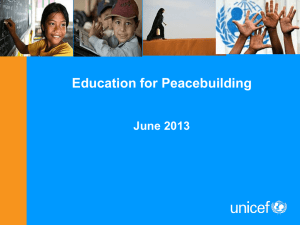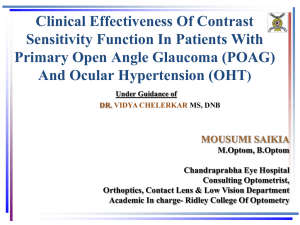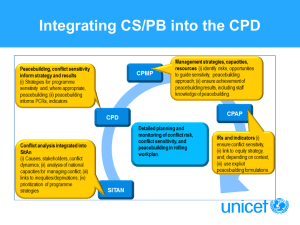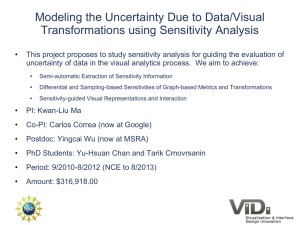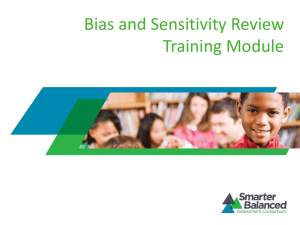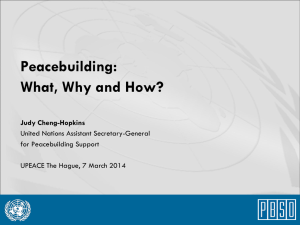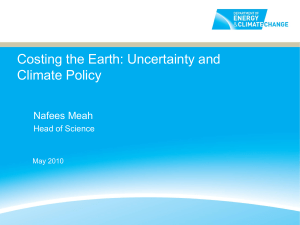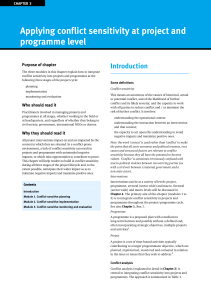INEE Working Group on Education and Fragility
advertisement
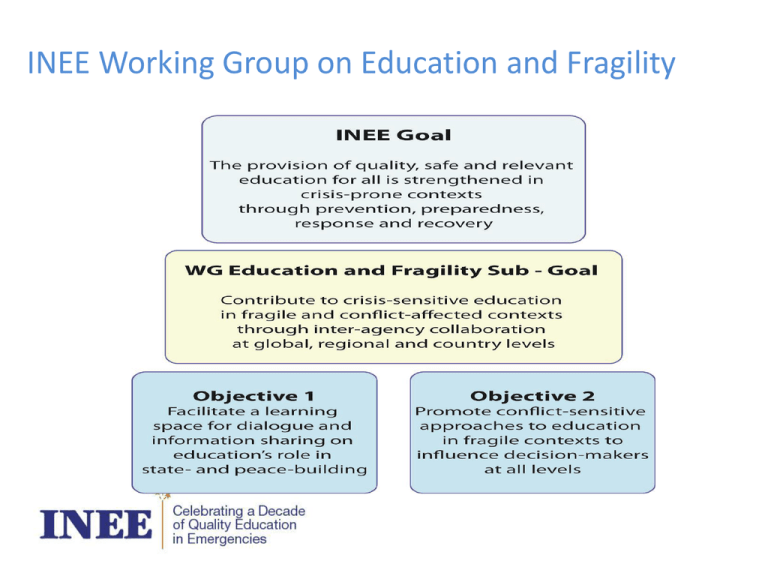
INEE Working Group on Education and Fragility Why conflict sensitivity? • An organisation is part of the context it operates in • We have intended and unintended results, positive & negative • Improve development results if we can reduce the unintended negative side-effects • Highly dynamic / fragile / conflict-affected operational contexts require an adapted working approach A Quick ‘Refresher’ – What is ConflictSensitivity? Conflict sensitivity refers to the ability of an organization to: Step1: Understand the context in which the organization operates; Step 2: Understand the interaction between the organization's intervention(s) and the context; and Step 3: Act upon the understanding of this interaction, in order to avoid negative impacts and maximize positive impacts. Conflict-Sensitivity vs. Peacebuilding? Conflict sensitivity is attributed to the working in conflict. Peacebuilding is attributed to the working on conflict. A Quick ‘Refresher’ – What is Conflict-Sensitivity? The conflict sensitivity cycle 10 principles for good engagement in fragile states and situations 1: Take context as a starting point 2: Do no harm 3: Focus on state building as the central objective 4: Prioritize prevention 5: Recognize the links between political security and development objectives 6: Promote non discrimination as a basis for inclusive and stable societies 7: Align with local priorities in different ways and in different contexts 8: Agree on practical coordination mechanisms between international actors 9: Act fast but stay engaged long enough to give success a chance 10: Avoid pockets of exclusion What we did…… • Process • Analysis • Next steps • Activity Overview •Process • Identified existing approaches of WG member agencies; • Identified commonalities, strengths and opportunities to further increase conflict sensitivity; • Shared analysis; • Now…..develop guiding questions; • Then….develop a ‘checklist’ for field practitioners. Existing Approaches Organization Conflict Sensitivity Consortium Resource Pack UNDP Bureau of Conflict Prevention and Recovery Definition of Conflict Sensitivity/ Key Aspects Conflict sensitivity refers to the ability of an organization to: - Understand the context in which the organization operates; - Understand the interaction between your intervention and the context; and - Act upon the understanding of this interaction, in order to avoid negative impacts and maximize positive impacts. Conflict sensitivity refers to the capacity of a development organization: - Understand the context in which it operates - Understand the interactions between the organization’s interventions and the context - Act upon this understanding to minimize harm and avoid negative impacts - Act to maximize the positive, peacebuilding impacts of development interventions Stages/ Components Source Guiding principles for implementing a conflict-sensitive approach: - Participatory process - Inclusiveness of actors, issues and perceptions - Impartiality in relation to actors and issues - Transparency - Respect for people’s ownership of the conflict and their suffering - Accountability for one’s own actions - Partnership and co-ordination - Complementarity and coherence - Timeliness Conflict Sensitivity Consortium (2004), Conflict-Sensitive Approaches to Development, Humanitarian Assistance and Peacebuilding: Resource Pack, available here Understanding the context, by conducting a thorough Conflict Analysis Understand the interactions between the development organization and the context, linking the results of conflict analysis with programming decisions Minimize harm, by conducting planning processes that ensure that as far as possible a balance is maintained in which all key stakeholders views are represented at all stages Maximizing peacebuilding impact, ensuring that programmes/ projects contribute to peacebuilding as much as possible, regardless of whether efforts are directly focused on contributing to peacebuilding UNDP BCPR (2009), “Compendium #1 – Planning, Monitoring and Evaluation in Conflict Prevention and Recovery Settings, BCPR”, in Guidelines for Planning, Monitoring and Evaluation in Conflict Prevention and Recovery Settings Existing Approaches World Bank Swiss Agency for Development and Cooperation (SDC) The World Bank has identified two fundamental components of conflictsensitive development practice: i) safeguarding against causation and/or escalation of conflict, and ii) capitalizing on opportunities for building peace to constructively manage future conflicts, should they arise. In an attempt to provide conflict sensitive development assistance, the World Bank adheres to the following eight principles: i) ‘do no harm’ particularly to avoid reinforcing or triggering conflict causes; ii) make peace dividends visible to the population; iii) include short-term issues, especially the restoration of security; iv) limit the potential for mass mobilization; v) address the structural causes of conflict; vi) address the perceptual and attitudinal legacy of the conflict; vii) ensure that development assistance is consistent and sustained; viii) consider the regional context. Conflict Sensitive Programme Management (CSPM) is a management approach that addresses values, procedures, tools and communications for steering development and humanitarian programmes and their projects in a context of political tensions, prior, during or after violent conflict. Conflict sensitivity, along with an awareness of the wider context, should permeate all stages of the project cycle. Creating and managing a constructive interchange is the challenge of conflict sensitive management. The SDC approach offers a tool box of frameworks and techniques that could be used at each stage of a conflict sensitive programme management cycle. Ruckstuhl, Sandra (2009), “Renewable Natural Resources: Practical Lessons for Conflict-Sensitive Development”, Conflict, Crime and Violence Issue Note, Social Development Department: The World Bank, September, available here World Bank (2007), Toward a ConflictSensitive Poverty Reduction Strategy: A Retrospective Analysis, World Bank, Second Edition, available here The Bank also stresses the need to apply a ‘conflict lens’ throughout the project cycle and ensure programs are flexible to change and adaptation. SDC, A Quick Guide: Conflict Sensitive Programme Management, available here SDC (2006), Conflict-sensitive Programme Management CSPM: Integrating conflict sensitivity and prevention of violence into SDC programmes, available here Helvetas (2010), Feedback from Conflict Sensitive Programme Management workshop in Tajikistan: Livelihood platform, available here Existing Approaches DFID USAID In order to be conflict sensitive, DFID, and the partners with whom they work, emphasis the need to appreciate the interaction between development activities and the potential for violent conflict, and design and adapt approaches and programmes accordingly. DFID also recognize that conflict-sensitivity applies to all contexts, not solely in countries currently affected by violent conflict. “In essence, conflict-sensitive programming involves explicit consideration of the role of development, humanitarian assistance, and peacebuilding programs and projects in contributing to conflict and promoting peace. Conflictsensitive programming applies to all phases of peace and conflict, from stable peace, to unstable peace or latent or pre-conflict, to manifest or violent conflict, to post-conflict.” DFID’s conflict sensitive approach includes the following key stages: Conducting a Country Governance Assessment (Conflict Analysis) Tailoring implementation/ service delivery accordingly conducting a ‘conflict audit’, using baselines from conflict analysis to monitor changes continually adapting and redefining program implementation according to changing circumstances Department for International Development UK (2006), Preventing Violent Conflict, DFID Policy Paper, available here In a USAID mission the ideal sequence in which to take steps in applying a conflict and peacebuilding perspective would be: i) The analysis of the causes of conflict and the causes of peace; ii) The development of a conflict-sensitive Country Strategic Plan (CSP) and conflict-sensitive programs; iii) Implementation of programs and activities; and iv) Ongoing monitoring for peace and conflict impacts, and evaluation including peace and conflict impacts, which would immediately feed back into the next programming cycle. Management Systems International (MSI) and USAID (2004), Analysis to Action: A Guidebook for Conflict-Sensitive USAID Programming in Africa, DRAFT, available here Existing Approaches GTZ/ BMZ Kenya Conflict Sensitive Consortium The Germany government, including GTZ and BMZ, has adopted a whole-ofgovernment approach to conflict sensitivity, essentially comprised of an early warning system and an appreciation of the nature of an intervention vis-à-vis conflict dynamics. The sector strategy aims at mainstreaming crisis prevention and conflict transformation as a crosssectoral issue with the intent to anchor conflict sensitivity in German development cooperation. Key Aspects: - Understanding the context and the conflict - Understanding the interaction between the intervention and that context - Acting upon that understanding of the contextual realities Key steps: 1. Start the (re)planning process with a peace and conflict assessment (PCA). 2. Define conflict-related objectives and strategies for the SED intervention 3. Select the appropriate SED approaches and management practices 4. Make the M and E system conflict-sensitive GTZ (2009), Sustainable Economic Development in Conflict-Affected Environments, German Federal Ministry for Economic Cooperation and Development, available here Note: The particular framework cited here adopts the general conflictsensitive framework of the government, specifically geared towards mainstreaming conflict sensitivity into Sustainable Economic Development (SED). The approach emphasis the need to afford a consideration of conflict Kenya Conflict Sensitivity Consortium (2011), sensitivity at the centre of programmatic interventions. The approach Conflict Sensitivity Practitioners’ Training notes that conflict sensitive lenses should applied to the analysis of the Manual, available here context, and in turn inform the development and implementation of the project cycle. Overview •Process •Analysis • Summary of current approaches; • Inputs consolidated and draft analysis prepared; • Shared with Sub-Group and Working Group; • Next steps …. Step 1: Understand your context…… Context Analysis, examining: • Conflict context factors • Actors involved In addition, consider: • Children/ School level • Community level • National level • Education system • Need to ensure context analysis is linked to program implementation and reflected in planning process. Step 2: Understand interactions between context and interventions • ‘How to’ guidelines/ checklists; • Training field staff and/or working with implementing partners; • “Do No Harm” principles • Need to maximize positive, transformational impact of education! • i.e. IRC’s ‘Healing Classrooms’ Step 2: Understand interactions between context and interventions • Indicators focus on: • Child protection and rights; • Equitable access; • Safe learning environments; • Resilience; • Policies vis-à-vis conflict; • “Do No Harm” • Need to consider interaction between organization, intervention, and conflict. Step 3: Develop options to maximize positive impact and minimize negative impact • Flexibility; • Revising analysis. • Again, need to ensure context analysis is linked to program implementation and reflected in planning process. Overview • Process • Analysis • Next steps • Guiding Questions • Checklist for Field Practitioners Activity The groups will be focusing at different levels: All groups are developing guiding questions. The guiding questions developed by those at the programme level will be based mainly on the three steps and will be further developed into a practical checklist. The guiding questions developed by those at the strategic level will be based mainly on the 10 principles for good engagement in fragile states and situations as a basis to develop the guiding questions.

